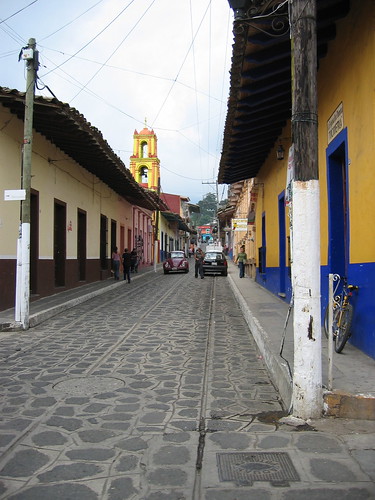Yesterday Fr. Dermot and I went to Naolinco. It is a small town I first encountered in 2001. It is a leather center. I bought a couple of pair of boots there which were custom made but not very good - at least for me. They must have a thousand leather shops which sell a lot of stuff that is created there and then shipped from Leon - which is another leather center. It is a religious town. A couple of major churches and then some memorials to victims of the Cristero movement. When I first went to Naolinco I spoke with a priest in one of the churches who described the cristero movement.
A significant element of the Mexican revolution involved a negative response to the Church which some saw as simply enforcers of the existing order. But until the mid-1920s and the reign of Plutarco Calles the restrictions on religion were only partially enforced. But Calles began to impose the laws harshly. The Constitution forbade religious schools and public displays of religion. Clerics were restricted severely in their civil rights - including prohibitions of the right to vote. But under Calles the repression of the church reached new heights for example, one priest was murdered for performing a baptism in Naolinco. The issues were felt especially in Jalisco (Guadalajara) and in places like Naolinco where religion is a part of life. Ultimately, some Catholics began armed resistance to the laws and it was quieted. The American ambassador at the time helped to negotiate a partial ceasefire but the laws stayed on the books until the late 1980s. There is a convent that we visited in Puebla (Convent of Santa Monica) which was also a secret to the city for many years because of the same religious intolerance. This is a footnote in Mexican history that is very interesting to me. Mexico, for me, is often a place of contrast and the landscape that faced religious orders and religious practice in a country that is heavily religious - is always interesting.
After spending a couple of hours walking around we went into a small restaurant off the square. It serves simple food - mole and Chili relenos are its specialities. The Chili Relenos were made with red chili not Poblanos and contained meat. But they were very good. We had a relaxed lunch and about the time we were going to leave a woman and her two daughters came up to us and began to speak. The woman had been a primary teacher and had a soft visage. She talked about her marriage (her husband died when she was young and with 3 children) and one daughter's bout with depression.
She soon discovered that Fr. Dermot was a priest - I constantly wonder about how Mexicans can figure him out - but I have repeatedly seen people come up to him and ask for a blessing. We talked with her and her daughters for probably 45 minutes. I think I got most of the conversation although did not contribute much to it. What I was struck with was her gentle but strong faith. I see it often in Mexico.
In the evening we came back to Xalapa and walked around a middle class shopping center. It was interesting to see a couple of things - in one of the regional equivalents of Wal Mart. They have the same selection as Wal Mart (which is actually up on the hill above the center we were in). I was impressed as I have been in the past how well the families seem to get on. The kids treat their siblings with a gentleness that is similar to the gentleness that I described in the woman in Naolinco.
I am impressed with the people of this region. They seem to have a balance in their lives and have a true commitment to their children.
It was a relaxed afternoon with a good friend.
Sunday, May 14, 2006
Discoveries in Naolinco
Subscribe to:
Post Comments (Atom)




No comments:
Post a Comment